从属连词及状语从句
- 格式:docx
- 大小:19.83 KB
- 文档页数:3
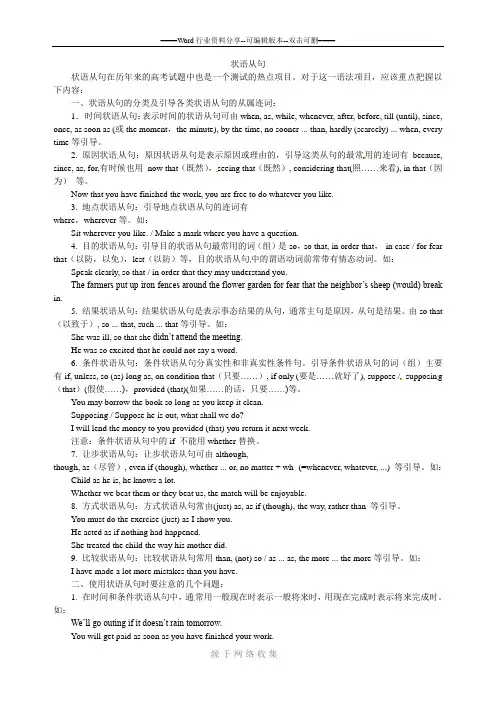
状语从句状语从句在历年来的高考试题中也是一个测试的热点项目。
对于这一语法项目,应该重点把握以下内容:一、状语从句的分类及引导各类状语从句的从属连词:1.时间状语从句:表示时间的状语从句可由when, as, while, whenever, after, before, till (until), since, once, as soon as (或the moment,the minute), by the time, no sooner ... than, hardly (scarcely) ... when, every time等引导。
2. 原因状语从句:原因状语从句是表示原因或理由的,引导这类从句的最常用的连词有because, since, as, for,有时候也用now that(既然),seeing that(既然), considering that(照……来看), in that(因为)等。
Now that you have finished the work, you are free to do whatever you like.3. 地点状语从句:引导地点状语从句的连词有where,wherever等。
如:Sit wherever you like. / Make a mark where you have a question.4. 目的状语从句:引导目的状语从句最常用的词(组)是so,so that, in order that,in case / for fear that(以防,以免),lest(以防)等,目的状语从句中的谓语动词前常带有情态动词。
如:Speak clearly, so that / in order that they may understand you.The farmers put up iron fences around the flower garden for fear that the neighbor’s sheep (would) break in.5. 结果状语从句:结果状语从句是表示事态结果的从句,通常主句是原因,从句是结果。
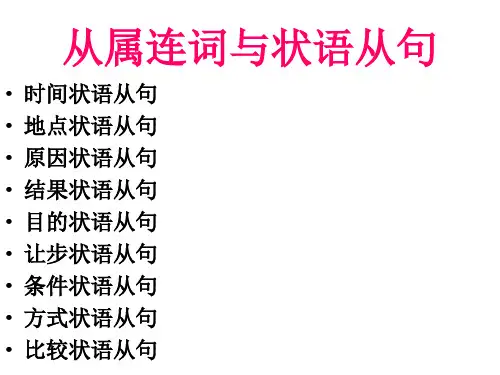
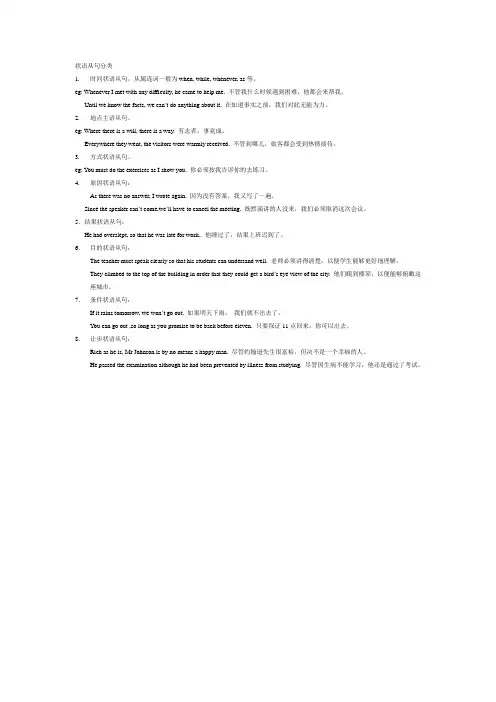
状语从句分类1.时间状语从句,从属连词一般为when, while, whenever, as等。
eg: Whenever I met with any difficulty, he came to help me. 不管我什么时候遇到困难,他都会来帮我。
Until we know the facts, we can’t do anything about it. 在知道事实之前,我们对此无能为力。
2.地点主语从句。
eg: Where there is a will, there is a way. 有志者,事竟成。
Everywhere they went, the visitors were warmly received. 不管到哪儿,旅客都会受到热情接待。
3.方式状语从句。
eg: You must do the exercises as I show you. 你必须按我告诉你的去练习。
4.原因状语从句:As there was no answer, I wrote again. 因为没有答案,我又写了一遍。
Since the speaker can’t come,we’ll have to cancel the meeting. 既然演讲的人没来,我们必须取消这次会议。
5.结果状语从句:He had overslept, so that he was late for work.. 他睡过了,结果上班迟到了。
6.目的状语从句:The teacher must speak clearly so that his students can undersand well. 老师必须讲得清楚,以便学生能够更好地理解。
They climbed to the top of the building in order that they could get a bird’s eye view of the city. 他们爬到楼顶,以便能够俯瞰这座城市。
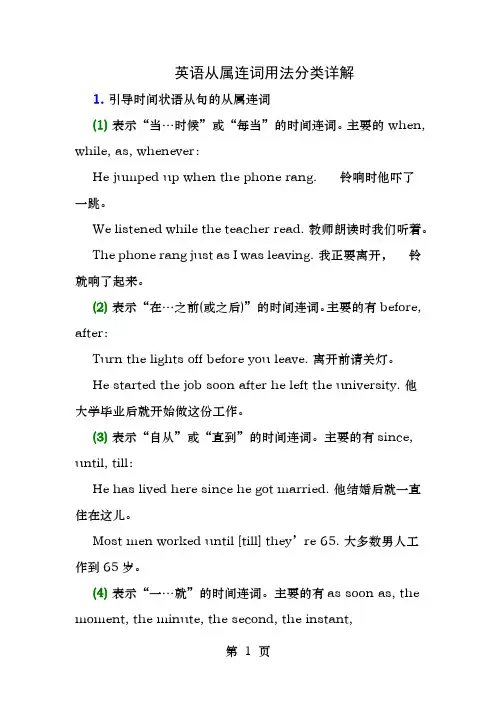
英语从属连词用法分类详解1. 引导时间状语从句的从属连词(1)表示“当…时候”或“每当”的时间连词。
主要的 when, while, as, whenever:He jumped up when the phone rang. 铃响时他吓了一跳。
We listened while the teacher read. 教师朗读时我们听着。
The phone rang just as I was leaving. 我正要离开,铃就响了起来。
(2)表示“在…之前(或之后)”的时间连词。
主要的有before, after:Turn the lights off before you leave. 离开前请关灯。
He started the job soon after he left the university. 他大学毕业后就开始做这份工作。
(3)表示“自从”或“直到”的时间连词。
主要的有since, until, till:He has lived here since he got married. 他结婚后就一直住在这儿。
Most men worked u ntil [till] they’re 65.大多数男人工作到65岁。
(4)表示“一…就”的时间连词。
主要的有as soon as, the moment, the minute, the second, the instant,immediately, directly, instantly, once, no sooner…than, hardly…when等:Tell him the news as soon as you see him. 你一见到他就把这消息告诉他。
I recognized her the moment (that) I saw her. 我一看到她就认出她来了。
I want to see him the minute (that) he arrives. 他一到来我就要见他。
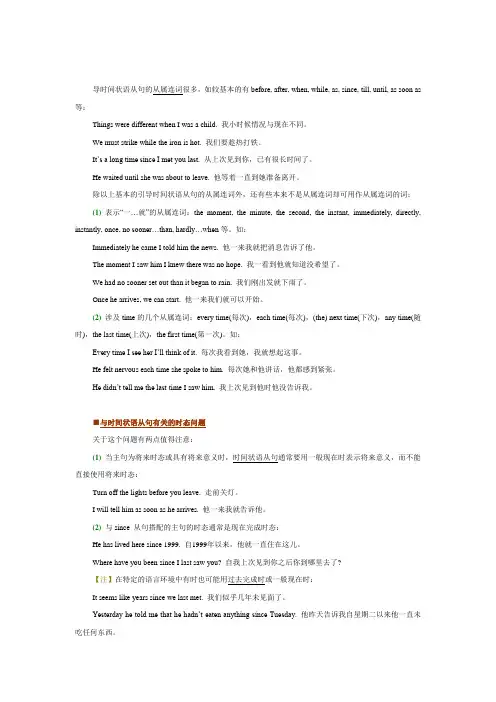
导时间状语从句的从属连词很多,如较基本的有before, after, when, while, as, since, till, until, as soon as 等:Things were different when I was a child. 我小时候情况与现在不同。
We must strike while the iron is hot. 我们要趁热打铁。
I t’s a long time since I met you last. 从上次见到你,已有很长时间了。
He waited until she was about to leave. 他等着一直到她准备离开。
除以上基本的引导时间状语从句的从属连词外,还有些本来不是从属连词却可用作从属连词的词:(1)表示“一…就”的从属连词:the moment, the minute, the second, the instant, immediately, directly, instantly, once, no sooner…than, hardly…when等。
如:Immediately he came I told him the news. 他一来我就把消息告诉了他。
The moment I saw him I knew there was no hope. 我一看到他就知道没希望了。
We had no sooner set out than it began to rain. 我们刚出发就下雨了。
Once he arrives, we can start. 他一来我们就可以开始。
(2)涉及time的几个从属连词:every time(每次),each time(每次),(the) next time(下次),any time(随时),the last time(上次),the first time(第一次)。
如:Every time I see her I’ll think of it. 每次我看到她,我就想起这事。
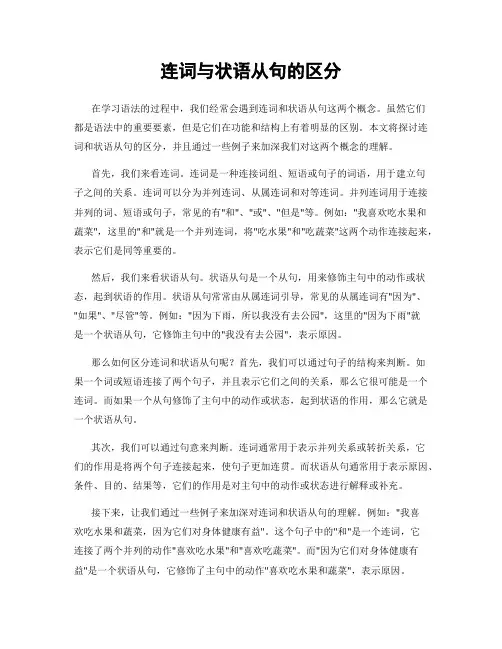
连词与状语从句的区分在学习语法的过程中,我们经常会遇到连词和状语从句这两个概念。
虽然它们都是语法中的重要要素,但是它们在功能和结构上有着明显的区别。
本文将探讨连词和状语从句的区分,并且通过一些例子来加深我们对这两个概念的理解。
首先,我们来看连词。
连词是一种连接词组、短语或句子的词语,用于建立句子之间的关系。
连词可以分为并列连词、从属连词和对等连词。
并列连词用于连接并列的词、短语或句子,常见的有"和"、"或"、"但是"等。
例如:"我喜欢吃水果和蔬菜",这里的"和"就是一个并列连词,将"吃水果"和"吃蔬菜"这两个动作连接起来,表示它们是同等重要的。
然后,我们来看状语从句。
状语从句是一个从句,用来修饰主句中的动作或状态,起到状语的作用。
状语从句常常由从属连词引导,常见的从属连词有"因为"、"如果"、"尽管"等。
例如:"因为下雨,所以我没有去公园",这里的"因为下雨"就是一个状语从句,它修饰主句中的"我没有去公园",表示原因。
那么如何区分连词和状语从句呢?首先,我们可以通过句子的结构来判断。
如果一个词或短语连接了两个句子,并且表示它们之间的关系,那么它很可能是一个连词。
而如果一个从句修饰了主句中的动作或状态,起到状语的作用,那么它就是一个状语从句。
其次,我们可以通过句意来判断。
连词通常用于表示并列关系或转折关系,它们的作用是将两个句子连接起来,使句子更加连贯。
而状语从句通常用于表示原因、条件、目的、结果等,它们的作用是对主句中的动作或状态进行解释或补充。
接下来,让我们通过一些例子来加深对连词和状语从句的理解。
例如:"我喜欢吃水果和蔬菜,因为它们对身体健康有益"。
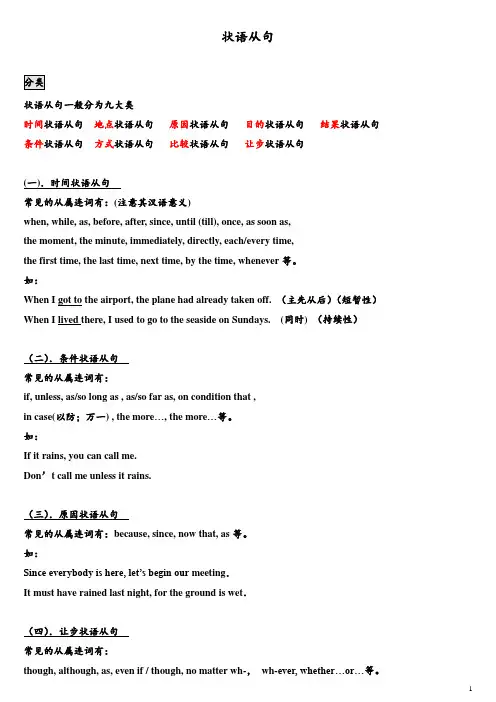
状语从句状语从句一般分为九大类时间状语从句地点状语从句原因状语从句目的状语从句结果状语从句条件状语从句方式状语从句比较状语从句让步状语从句(一).时间状语从句常见的从属连词有:(注意其汉语意义)when, while, as, before, after, since, until (till), once, as soon as,the moment, the minute, immediately, directly, each/every time,the first time, the last time, next time, by the time, whenever等。
如:When I got to the airport, the plane had already taken off. (主先从后)(短暂性)When I lived there, I used to go to the seaside on Sundays. (同时) (持续性)(二).条件状语从句常见的从属连词有:if, unless, as/so long as , as/so far as, on condition that ,in case(以防;万一) , the more…, the more…等。
如:If it rains, you can call me.Don’t call me unless it rains.(三).原因状语从句常见的从属连词有:because, since, now that, as等。
如:Since everybody is here, let’s begin our meeting.It must have rained last night, for the ground is wet.(四).让步状语从句常见的从属连词有:though, although, as, even if / though, no matter wh-,wh-ever, whether…or…等。
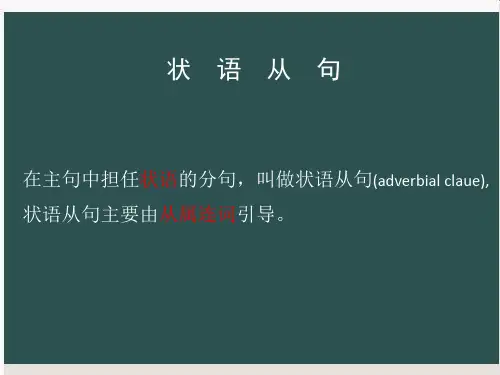
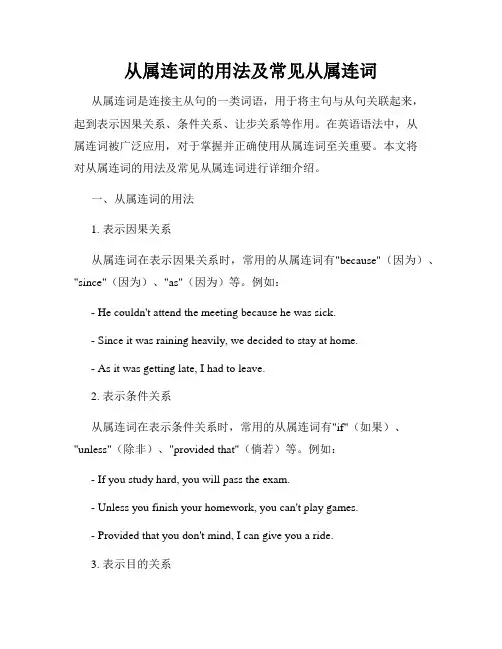
从属连词的用法及常见从属连词从属连词是连接主从句的一类词语,用于将主句与从句关联起来,起到表示因果关系、条件关系、让步关系等作用。
在英语语法中,从属连词被广泛应用,对于掌握并正确使用从属连词至关重要。
本文将对从属连词的用法及常见从属连词进行详细介绍。
一、从属连词的用法1. 表示因果关系从属连词在表示因果关系时,常用的从属连词有"because"(因为)、"since"(因为)、"as"(因为)等。
例如:- He couldn't attend the meeting because he was sick.- Since it was raining heavily, we decided to stay at home.- As it was getting late, I had to leave.2. 表示条件关系从属连词在表示条件关系时,常用的从属连词有"if"(如果)、"unless"(除非)、"provided that"(倘若)等。
例如:- If you study hard, you will pass the exam.- Unless you finish your homework, you can't play games.- Provided that you don't mind, I can give you a ride.3. 表示目的关系从属连词在表示目的关系时,常用的从属连词有"so that"(以便)、"in order that"(为了)等。
例如:- I bought a new laptop so that I can work more efficiently.- They left a note in order that we would know where they went.4. 表示比较关系从属连词在表示比较关系时,常用的从属连词有"than"(比)、"as"(和)等。
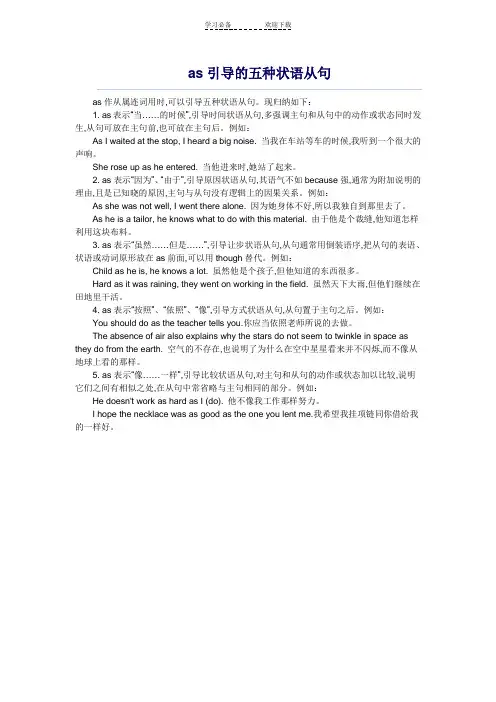
as作从属连词用时,可以引导五种状语从句。
现归纳如下:1. as表示“当……的时候”,引导时间状语从句,多强调主句和从句中的动作或状态同时发生,从句可放在主句前,也可放在主句后。
例如:As I waited at the stop, I heard a big noise. 当我在车站等车的时候,我听到一个很大的声响。
She rose up as he entered. 当他进来时,她站了起来。
2. as表示“因为”、“由于”,引导原因状语从句,其语气不如because强,通常为附加说明的理由,且是已知晓的原因,主句与从句没有逻辑上的因果关系。
例如:As she was not well, I went there alone. 因为她身体不好,所以我独自到那里去了。
As he is a tailor, he knows what to do with this material. 由于他是个裁缝,他知道怎样利用这块布料。
3. as表示“虽然……但是……”,引导让步状语从句,从句通常用倒装语序,把从句的表语、状语或动词原形放在as前面,可以用though替代。
例如:Child as he is, he knows a lot. 虽然他是个孩子,但他知道的东西很多。
Hard as it was raining, they went on working in the field. 虽然天下大雨,但他们继续在田地里干活。
4. as表示“按照”、“依照”、“像”,引导方式状语从句,从句置于主句之后。
例如:You should do as the teacher tells you.你应当依照老师所说的去做。
The absence of air also explains why the stars do not seem to twinkle in space as they do from the earth. 空气的不存在,也说明了为什么在空中星星看来并不闪烁,而不像从地球上看的那样。
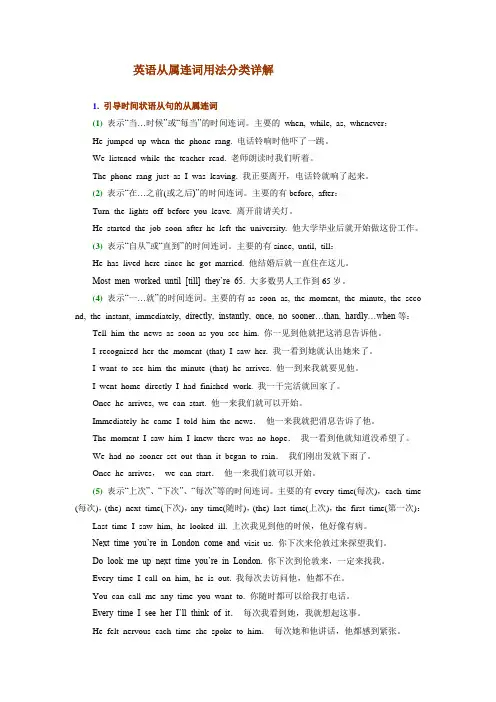
英语从属连词用法分类详解1. 引导时间状语从句的从属连词(1)表示“当…时候”或“每当”的时间连词。
主要的when, while, as, whenever:He jumped up when the phone rang. 电话铃响时他吓了一跳。
We listened while the teacher read. 老师朗读时我们听着。
The phone rang just as I was leaving. 我正要离开,电话铃就响了起来。
(2)表示“在…之前(或之后)”的时间连词。
主要的有before, after:Turn the lights off before you leave. 离开前请关灯。
He started the job soon after he left the university. 他大学毕业后就开始做这份工作。
(3)表示“自从”或“直到”的时间连词。
主要的有since, until, till:He has lived here since he got married. 他结婚后就一直住在这儿。
Most men worked until [till] they’re 65. 大多数男人工作到65岁。
(4)表示“一…就”的时间连词。
主要的有as soon as, the moment, the minute, the seco nd, the instant, immediately, d irectly, instantly, once, no sooner…than, hardly…when等:Tell him the news as soon as you see him. 你一见到他就把这消息告诉他。
I recognized her the moment (that) I saw her. 我一看到她就认出她来了。
I want to see him the minute (that) he arrives. 他一到来我就要见他。
状语从句和定语从句的用法对比状语从句和定语从句是英语语法中的两个重要子句结构,它们在句子中分别充当状语和定语的作用。
本文将对这两种从句进行详细比较和探讨。
一、状语从句的用法状语从句是在复合句中充当状语的子句结构。
它可以表示时间、地点、目的、原因、条件等多种状语关系。
状语从句一般由从属连词引导,如when,where,because,if等。
下面是一些常见的状语从句的用法和例句:1. 时间状语从句:表示主句的动作发生的时间,常用从属连词when,while,before,after等引导。
例如:- He always goes to bed early when he feels tired.(当他感到疲倦时,他总是早睡。
)- They will have a party after they finish their exams.(他们考完试后将举行一个派对。
)2. 地点状语从句:表示主句的动作发生的地点,常用从属连词where引导。
例如:- He likes to go to the park where he can enjoy nature.(他喜欢去公园,在那里他可以享受大自然。
)3. 原因状语从句:表示引起主句动作的原因,常用从属连词because,since,as等引导。
例如:- They couldn't come to the party because they were busy.(因为他们很忙,所以不能参加派对。
)4. 目的状语从句:表示主句动作的目的,常用从属连词so that,in order that引导。
例如:- He studies hard so that he can get a good grade.(他努力学习,以便能得到一个好成绩。
)5. 条件状语从句:表示在什么条件下主句的动作才会发生,常用从属连词if,unless,provided等引导。
例如:- If it rains tomorrow, we will stay at home.(如果明天下雨,我们会呆在家里。
导时间状语从句的从属连词很多,如较基本的有before, after, when, while, as, since, till, until, as soon as 等:Things were different when I was a child. 我小时候情况与现在不同。
We must strike while the iron is hot. 我们要趁热打铁。
I t’s a long time since I met you last. 从上次见到你,已有很长时间了。
He waited until she was about to leave. 他等着一直到她准备离开。
除以上基本的引导时间状语从句的从属连词外,还有些本来不是从属连词却可用作从属连词的词:(1)表示“一…就”的从属连词:the moment, the minute, the second, the instant, immediately, directly, instantly, once, no sooner…than, hardly…when等。
如:Immediately he came I told him the news. 他一来我就把消息告诉了他。
The moment I saw him I knew there was no hope. 我一看到他就知道没希望了。
We had no sooner set out than it began to rain. 我们刚出发就下雨了。
Once he arrives, we can start. 他一来我们就可以开始。
(2)涉及time的几个从属连词:every time(每次),each time(每次),(the) next time(下次),any time(随时),the last time(上次),the first time(第一次)。
如:Every time I see her I’ll think of it. 每次我看到她,我就想起这事。
because引导原因状语从句1. 结构:原因状语从句通常由从属连词"because"引导,后面跟着一个完整的句子。
2.位置:原因状语从句可以置于主句之前或之后,具体位置取决于句子的语气和语境。
-如果原因状语从句在句首,通常需要用逗号与主句隔开。
例如:"Because it was raining, we stayed indoors."-如果原因状语从句在句尾,一般不需要逗号。
例如:"We stayed indoors because it was raining."3. 引导词替代:除了"because",其他常见的引导词有"since"、"as"、"due to"、"owing to"等。
它们在引导原因状语从句时具有相同的作用。
例如:"Since I had an early meeting, I couldn't stay out late."4. 强调结构:有时候,为了强调原因状语从句,可以使用"because of"加名词或代词的形式。
例如:"He couldn't attend the meeting because of his illness."5. 注意点:-原因状语从句解释主句的原因,因此主句是结果或效果,而从句是原因或解释。
-原因状语从句不能独立成句,它必须与主句一起构成完整的意思。
-原因状语从句可以回答"why"的问题,解释为什么某个行为或情况发生。
下面是一些例句,展示了"because"引导原因状语从句的用法:1、She didn't go to the party because she had to study for her exam.她没去参加聚会,因为她得准备考试。
从属连词及状语从句 状语从句概念:用一个句子(从句)来作另一个句子(主句)的状语,用作状语的句子就叫作状语从句。作什么样的状语就叫什么类型的状语从句。引导状语从句的连接词是从属连词,状语从句可以在句首,也可以在句尾。 中考主要考查状语从句的类型有: 时间状语从句、地点状语从句、原因状语从句、结果状语从句、目的状语从句、条件状语从句及比较状语从句等。 1. 时间状语从句 时间状语从句在主句中表示时间,常用连接词有:when(当…时),while(当…时),as(当…时),before(在…之前),after(在…之后),since(自从),not…until(直到……才),as soon as(一…就),once(一旦…就)等。 I didn’t go to bed until I finished my homework. 我直到做完作业才去睡觉。 I can listen to the radio while I work. 我可以边听收音机边工作。 (1) 时间状语从句中,一般要用一般现在时代替一般将来时,一般过去时代替过去将来时。 I will telephone you when he comes. 他来时,我会给你打电话。 (2) when引导时间状语从句,表示主句的动作和从句的动作同时或先后发生,从句的谓语可以是延续性动词,也可以是瞬间动词。 He was working when I went in. 我进去时他正在工作。 When she heard the news, she began to cry. 她听到这个消息,她哭了起来。 (3) while引导的状语从句中常用延续性动词或表示状态的动词,意为“在…期间”。while还表示两者间的对比关系。 They rushed in while we were singing. 我们唱歌时,他们冲进来。 I like playing football, while Tom likes listening to music.我喜欢踢足球,而汤姆喜欢听音乐。 (4) as引导状语从句,强调同时发生,不分先后。可以译成“随着”或“一边……一边”。 John sings as he walks home. 约翰一边往家走一边唱歌。 (5) since引导状语从句,主句常用现在完成时,从句常用一般过去时。 We have been friends since we met in Beijing.自从我们在北京遇到就一直是朋友。 It has been six years since she left school.自从她毕业已经有六年了。 6) until/ till引导时间状语从句,当主句的谓语动词是瞬间动词时,主句常用否定形式,not…until直到…才 He didn’t go to bed until he finished his homework. 他直到做完作业才睡觉。 2.地点状语从句 地点状语从句在主句中表示地点。其连接词有where(哪里),wherever(无论哪里)等。 Put it where you find it. 把它放在原来的地方。 You can sit wherever you like. 你喜欢坐在哪里就坐在哪里。 3. 原因状语从句 原因状语从句在主句中表示原因或者理由。其连接词有:because(因为),as (因为),since(既然)等。 I often eat carrots because they are good for my health.我经常吃胡萝卜是因为对我的身体有好处。 As I don’t know the way, I had to ask the policeman.由于我不知道路,所以我不得不问警察。 (1) because表示因果关系语气最强,常用来回答why提出的问题。 I didn’t tell them because they were too young.我没有告诉他们,因为他们太小。 (2) because和so不能同在一个句子里。Because the book was expensive, I didn’t buy it. (I 前不用so) 4.结果状语从句 结果状语从句在主句中表示结果。其连接词有:so…that…(如此…以至于…),such…that…(如此…以至于…)等。 It’s such a good chance that you can’t miss it. 这次机会如此好,你不能失去它。 注意:so…that 和 such …that 都可以引导结果状语从句,注意so和such后面所接的词不同。 (1) such... that such+a(an)+形容词+单数可数名词+that从句 such+形容词+复数名词/不可数名词+that从句 He was such an honest man that he was praised by the teacher.他非常诚实,因而受到了老师的表扬。 They are such interesting novels that I want to read them once again.这些小说非常有趣,我想再读一遍。 (2)但是如果名词前由many、much、few、little(少)等词修饰,则用so。 He had so many falls that he was black and blue all over.他摔了很多跤,以至于全身上下青一块,紫一块的。 (3) so ... that so+形容词/副词.+that从句 so+形容词+a(an)+单数可数名词+that从句 He runs so fast that nobody can catch up with him.他跑得非常快,没人能追上他。 Dr. Wang is so good that everybody loves and respects him.他是一位好医生,大家都尊敬并爱戴他。 =He is so good a doctor that everybody loves and respects him. =He is such a good doctor that everybody loves and respects him. 5. 目的状语从句 目的状语从句在主句中表示目的。其连接词有:so(以便),so that(为了),in order that(为了)等,从句中多用情态动词can, will, may, should 等。 He got up very early so that he could catch the first train.他起床很早以便于赶第一班火车。 6. 条件状语从句 条件状语从句在主句中表示条件。其连接词有:if(如果),unless (如果不,除非),as long as(只要)等。 If it is fine tomorrow, we will go swimming.如果明天天气好的话我们去游泳。 注意:在条件状语从句中,一般要用一般现在时代替一般将来时,一般过去时代替过去将来时。 Unless it rains, the game will be played.(= If it doesn’t rain, the game will be played.)如果不下雨,比赛就将进行。 As long as you tell truth , I’ll try to help you.只要你说出真相,我就尽力帮助你。 7. 让步状语从句 常由though/although (虽然),even if/ though (即使)等引导,但though/although不能和but同时出现在一个句子里。 Though it’s hard work, I enjoy it.(= It’s hard work, but I enjoy it.)尽管这是一件艰苦的工作,但我乐意做。 She won’t leave the TV set even though /even if supper’s on the table.即使晚饭已摆在桌上,她也不愿意离开电视机。 真题再现 1. — Mrs. Li, will you be angryyour students don’t obey the rules in class?(2014 山西) — A little. But I will stop them in a friendly way. A. if B. unless C. though 2. jeans were invented over 100 years ago, they're still in fashion today.(2014 江西) A. Because B. If C. Although D. Since 3. The teacher asked me to read aloud all the students could hear me.(2014 滨州) A. so that B. for C. because D. in order to 4. — The air pollution is terrible. (2014 扬州) — It will be worse we take action to protect the environment. A. if B. unless C. until D. when 5. Lin Feng has to work late, she always wears a smile on her face. (2014 南京) A. Because B. If C. Until D. Though 6. In summer milk will quickly go bad it is put into a fridge. (2014 杭州) A. though B. unless C. because D. once 7. I don’t like TV series it’s boring.(2015 青海) A.but B.and C.because 8. Mr. Smith has a habit of taking a showerhe has breakfast. (2015 温州) A. though B. before C. because D. since 9.You’d better travel around Nanjing with a local tour guideyou want to know more about its culture. (2015 南京) A.unless B.until C.although D.if 10. Pandas are facing danger! The situation won’t changehumans stop killing.(2015 南通) A.unless B.though C.if D.after 11. — Jenny, will you leave for the USA now? — No. It will be two weeks I leave here. A. until B. since C. before D. when 12. my cousin is very young, she can help with the housework.(2015 福州) A. Once; 不填 B. Though; but C. Although; 不填